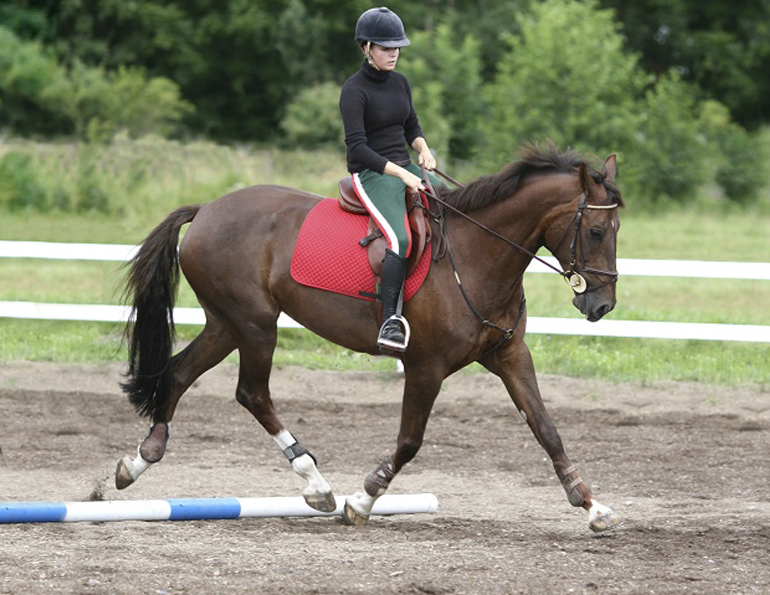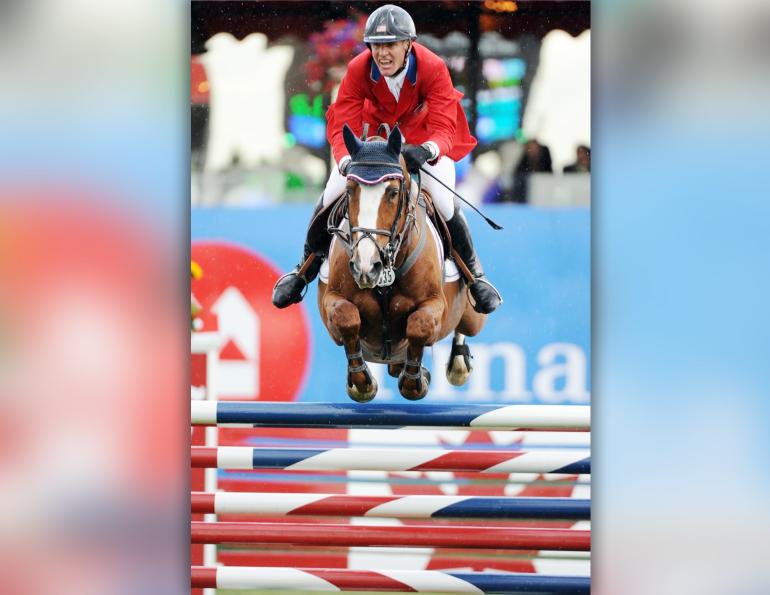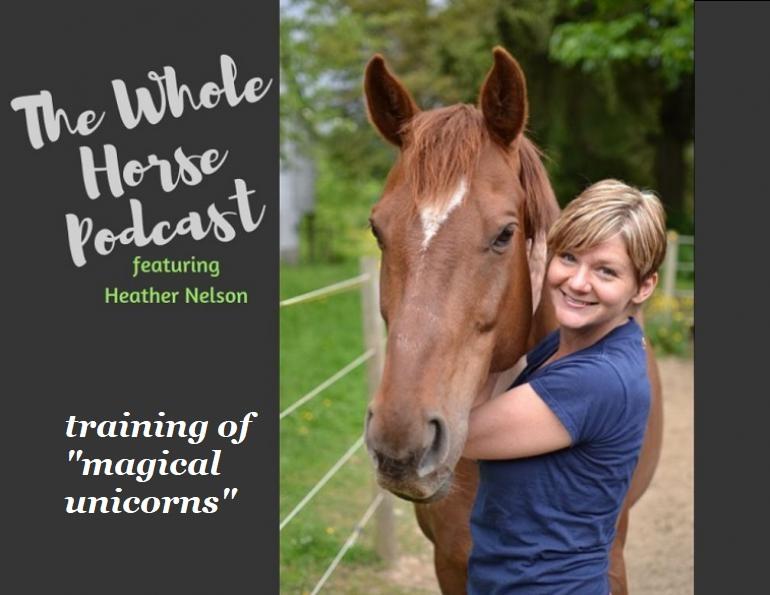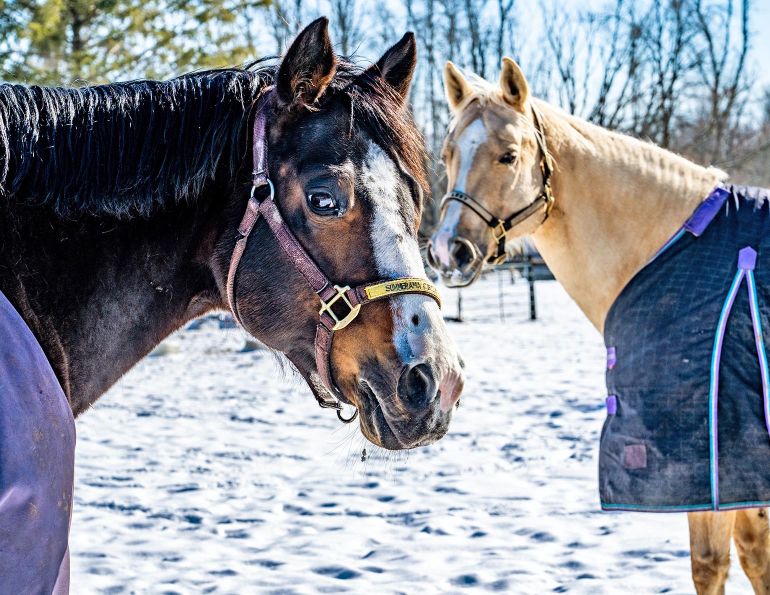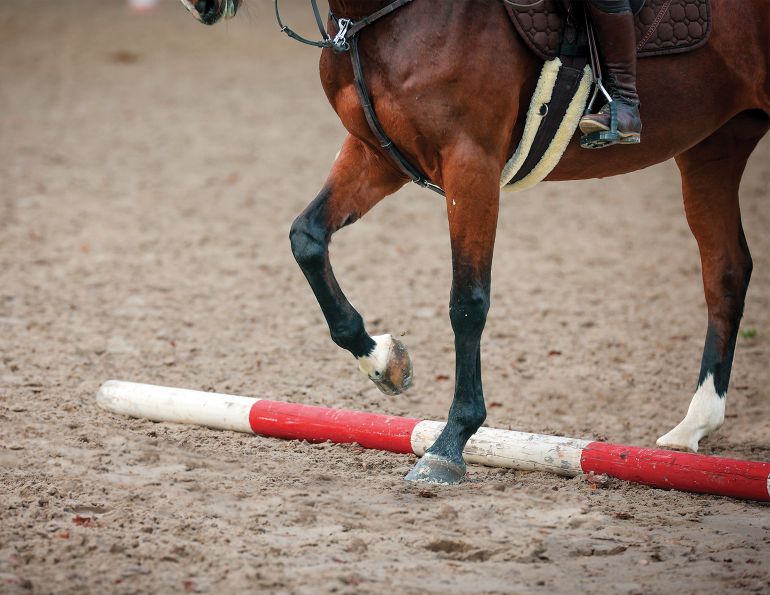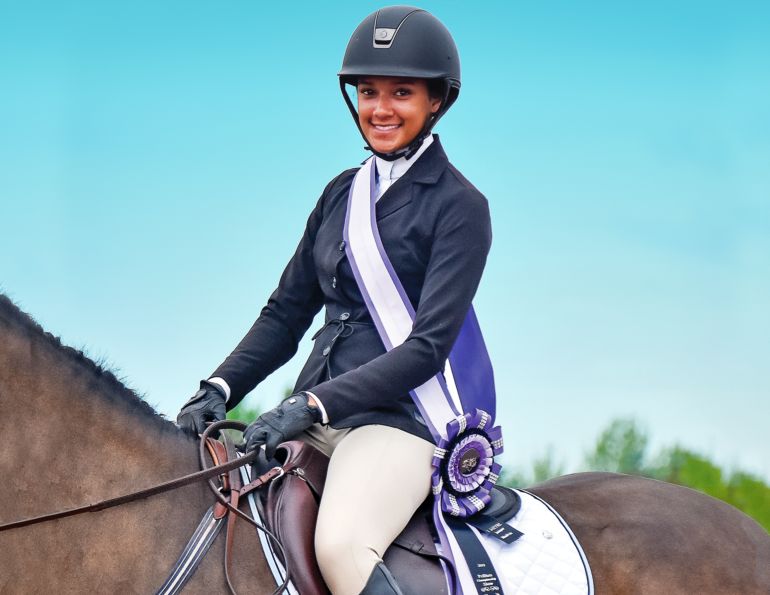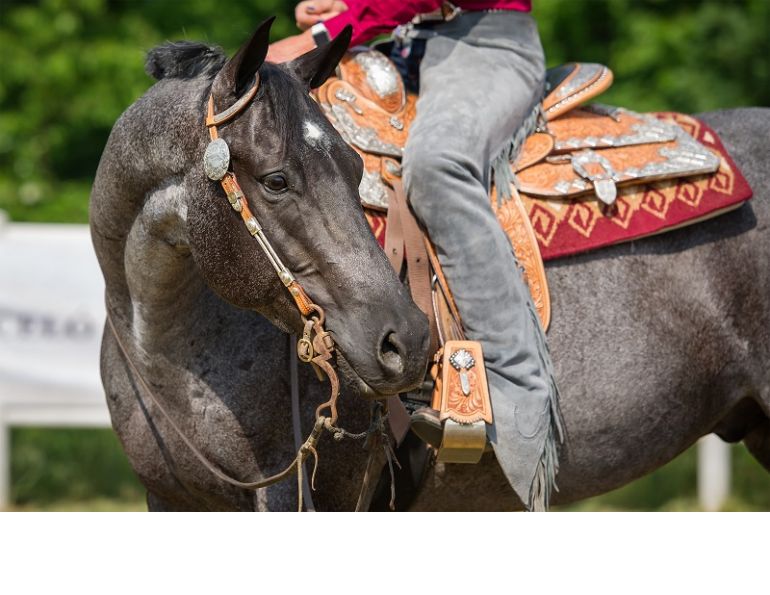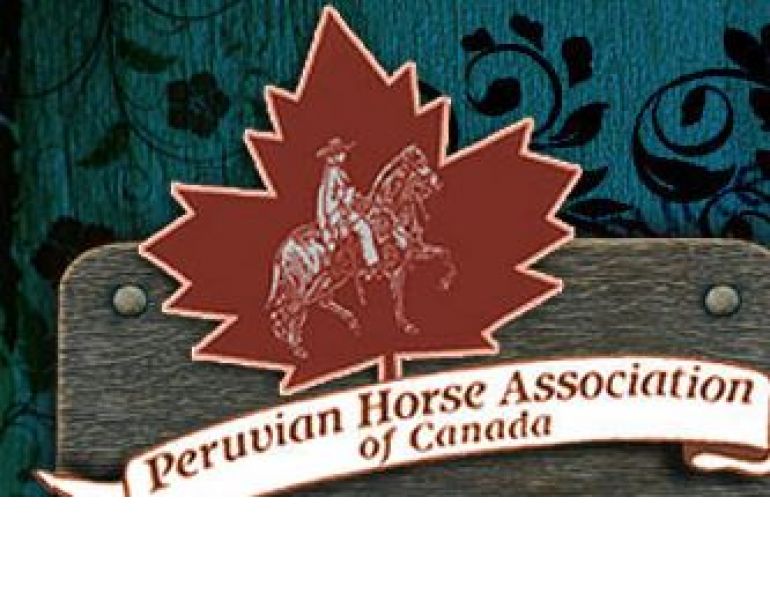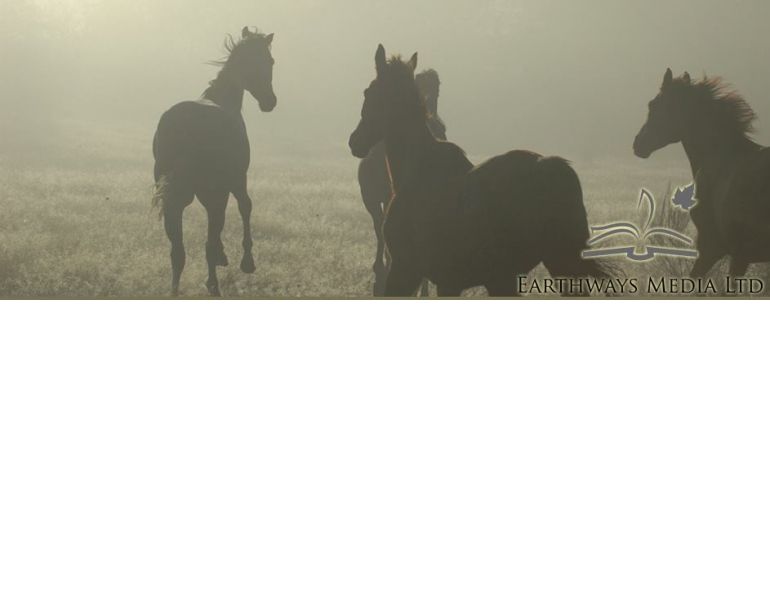Simple Exercises and Routines to Reprogram Dysfunctional Movement
By Jec A. Ballou
As tempting as it is to use our riding skills and training expertise when teaching a horse to carry his body differently or when rehabbing post-layoff, this actually slows the process down. Somehow, many of us equestrians missed this crucial fact during our educations. The horse’s big, fleshy gymnastic muscles that engage as we school him are not the ones where habitual patterns, sometimes called “muscle memories,” are stored. Nor are they the ones responsible for joint and posture stability. In fact, they carry a low supply of nerves and have, therefore, a weak relationship with the horse’s neurosensory system. Working these muscles is not the fastest way to instate new patterns and habits.
When patterns need to be changed or introduced, we must access the muscles close to his spine and around joints, which carry a large supply of nerves and pathways that create the language for how a horse moves. This means using exercises outside our regular training routines, ones that have direct communication to his central nervous system. These are what I call calisthenics, or finely controlled movements that access these slow twitch muscles. In physical therapy, they are often called corrective exercises. By bringing these muscles through specific movements without allowing the large gymnastic muscles to take over, new neural pathways are established. Until this occurs, we would be trying to speak a language for which the horse has no vocabulary.
For instance, rather than getting on and immediately beginning to school a stiff-necked Thoroughbred that showed up recently for training, I spent the first several days performing unmounted movement patterns and stretches like the ones suggested below. It can take six months or more to change distribution of muscle mass and tone, but studies have shown that new pathways for muscle recruitment, and a new language in the nervous system, can happen in six weeks of consistent routines. The following exercises stimulate the nervous system in ways that, when practiced consistently, lead to permanent changes. Depending on the extent of the rehab or poor posture that you’d like to change, I recommend following a program that performs only the following exercises, and avoid regular riding exercise where the horse uses existing patterns, for a focused period of anywhere from seven days to three weeks. After that period, continue practicing these exercises, but also begin to add 20 to 30 minutes of regular gymnastic work — flatwork, trail riding, lessons.
Tune Proprioception with Surfaces
In physical therapy programs, trainers use an area of alternating surfaces called a sensory re-education path. It includes repeating three-meter segments of pebbles, firm ground, and sand. Walking the horse through these surfaces causes his neuro-receptors to function rapidly. These adaptations get stored in the horse’s overall motor control. Therapists often think of this as “waking up” the horse’s nervous system. In the same way that muscles atrophy from under-use, nerves can become dull or shut off from injury, trauma, or time off. Helping them fire again through use of sensory re-education paths can help restore mobility and function to areas of your horse’s neuromuscular system that are stuck.
In the absence of a formal path like this, you can create a similar experience by treading across the various surfaces immediately near your barn. At our barn, we have a paved driveway, a grassy lawn, a section of wood chips, and a sandy paddock all close to each other. I ride figure-eight and serpentine patterns across these changing surfaces to mimic the sensory path used by therapists. I recommend aiming to do this three times per week for five to ten minutes, asking your horse to walk and jog slowly across these constantly changing surfaces.
Similarly, nerve signals can also be “woken up” through cutaneous stimulation. This involves using a firm object like a pen cap to gently scratch along the horse’s skin to generate reflexes. For instance, you can scratch or tickle alongside the horse’s sacrum to create lateral and longitudinal flexion in his pelvis. Experiment with your own horse to see what reflexes you can achieve using only light pressure. Many riders discover that by tickling under the horse’s belly, they can help him learn how to lift his back reflexively.
Stimulating reflex points like this triggers his deep supporting muscles rather than the large gymnastic ones. Cutaneous stimulation can be effective along the croup and gluteal muscles for horses recovering from hindquarter dysfunction or stiffness. It is sometimes also used along the horse’s oblique muscles when the sides of a horse’s ribcage have become deadened by overuse of a rider’s spur or leg aids.
Related: Walking Workouts for Your Horse
Add a Drop
The value of exercise on sloped terrain has become a well-established tool for building up a horse’s body. It equalizes the use of a horse’s hind legs when crookedness exists in addition to causing the horse to flex his hind joints. If you lack hills or the time to reach them, you can accomplish a lot with a simple ditch like the ones found near most culverts. Commonly ridden by three-day eventers, a ditch – where the horse negotiates a steep downhill drop for three to four steps and then immediately climbs back up the other side – requires coordination between front and hind ends, plus quick adjustments of balance. These adjustments help unblock postures where there is a lack of mobility. If you have access to a ditch, aim to ride across it as slowly as possible, keeping the horse absolutely straight and not swinging his hindquarters around, five to eight times daily.

Exercise on sloped terrain is valuable for reducing crookedness, and improving coordination and balance. In the absence of a hill, a ditch can serve the same purpose. Ride slowly across it keeping the horse straight, without allowing him to swing his quarters around, five to eight times a day. Photo courtesy of Jec Ballou
Lateral Exercises
Lateral movements executed from the ground at a walk can serve as therapeutic treatment for poor postural condition in a horse’s hips and spine. Because they require a rearranging of neuromuscular coordination, these exercises improve proprioception of joints, tendons, and muscles. This produces better locomotion. Even in cases where lateral movements are not performed at a competition level, they still play a physiological development role. A few minutes of asking a horse to execute shoulder-in from the ground before riding, for example, activates the stifle joint and psoas muscles. It can mobilize the rib cage and pelvic stabilizers. This kind of lateral work as physical therapy can be executed in either a bridle or halter. I recommend spending five minutes total each day, practicing leg-yield, shoulder-in, turns on the haunches, and haunches-in.
Related: Equine Rehab for the Not-Quite-Right Horse

Lateral movements executed from the ground at a walk produce better locomotion by improving proprioception of joints, tendons, and muscles. Photo: Dreamstime/Donna Kilday
Poles with Purpose
Patterns of ground poles are frequently used to rehabilitate horses from injury or to correct neurological conditions owing to their role in altering a horse’s patterned movement and recruiting stabilizing muscles. Ground poles tune up the horse’s sensory nerves by making him more aware of where his feet are. This creates better reaction and agility, muscular coordination, and lighter movement in the front end. Also, as the horse takes measured strides with distances set by poles, he corrects gait irregularities and poor rhythm. These gait abnormalities can include uneven use of hind legs, an irregularity in his movement, and persistent crookedness. Depending on which condition needs to be corrected, a variety of pole routines can be used. The following three set-ups are good general patterns for toning hip stabilizers, improving joint flexion, and eliminating muscular bracing habits.
Snake Over Poles (figure 1)

Place six to eight poles touching end to end in a long straight line on the ground. You can either raise the poles a few inches off the ground or leave them flat on the sand. In a slow walk with light rein contact, ride a tight serpentine that crosses back and forth across the line of poles. Your loops should be very small so that you remain close to the pole rather than drifting out away from it. This exercise is equally valuable when hand-walked or for ground-driving if your horse is not able to be ridden.
Raised Fan (figure 2)

Use five poles to create a fan shape with the inside ends of the poles raised six to eight inches off the ground. Place the raised ends of the poles so they are two feet apart from each other. Measure the centre of the poles to be four feet apart from each other. The outside edge of the poles should measure six feet apart from each other. Begin by riding around the inside edge of the fan on a tiny, slow-motion circle. Be sure the horse takes only a single step between each pole. Now, enlarge your circle to cross over the outer edge of all five poles, aiming to get three steps between each pole. Continue repeating this sequence and stride count.
Pick-Up Sticks (figure 3)
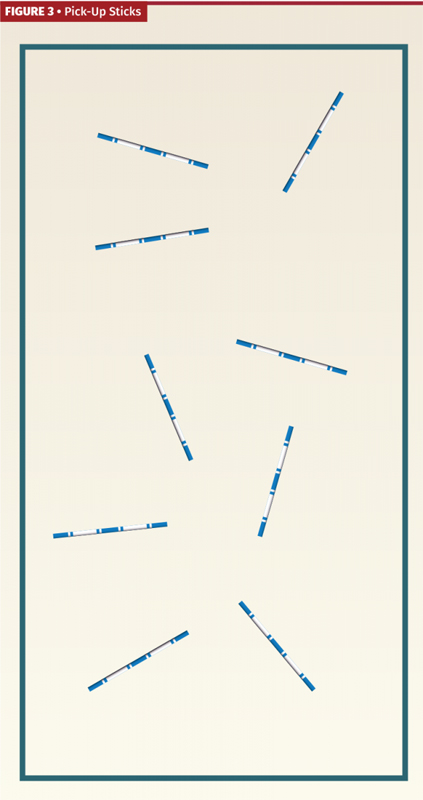
Using as many poles as you have access to, scatter them around the arena in a random way. Place some close to each other, others far apart. Now, ride around the arena in walk/jog crossing over the poles with all kinds of loops, curves, zig-zags. Cross the poles using all kinds of patterns — straight across and obliquely. Ride three-minute circuits like this, constantly changing your order of riding over the poles. After three minutes, rest for one minute, and then repeat.
Related: The Benefits of Cantering Your Horse
Abide the Prescription of Dynamic Stretches
Dynamic stretches, commonly called “carrot stretches” owing to the use of carrot baits, can measurably change the tone of a horse’s postural muscles when practiced at least five days per week. Three separate studies conducted by Michigan State University measured an enlargement of horses’ supporting back muscles by two centimetres when they practiced these movements daily for six weeks. This activation of spinal stabilizers equaled better symmetry and balance, more efficient movement, and in some cases alleviated pain that was affecting performance. These are an easy, effective way to activate dormant muscles.
Practice these three simple maneuvers every day with your horse, using a bait or not as dictated by your horse (figure 4).
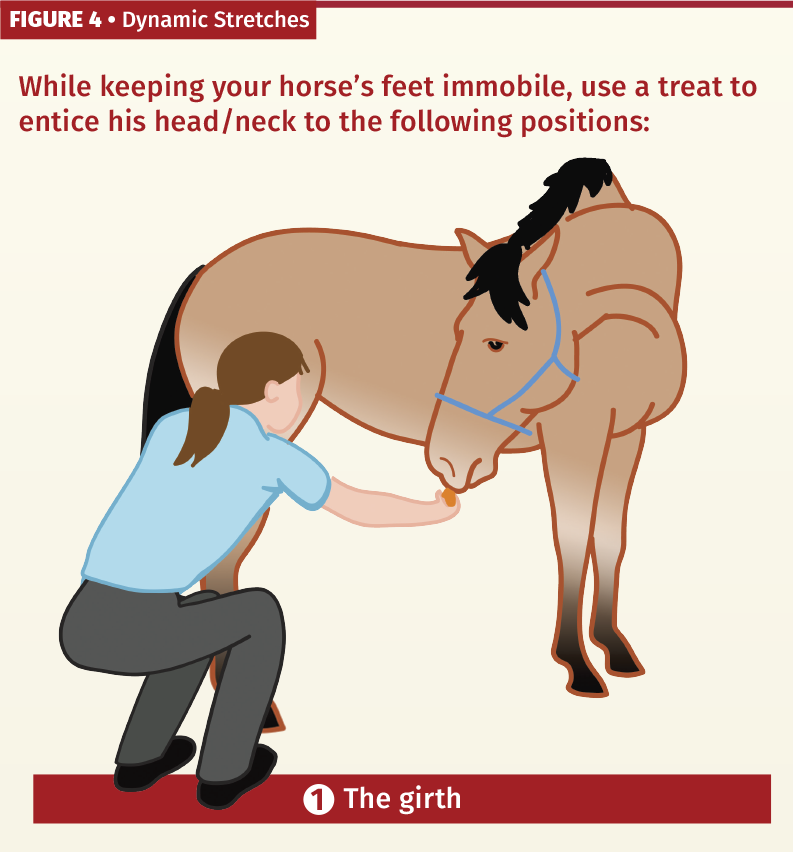
1) While keeping the horse standing square and motionless, slowly entice the horse’s head around towards his girth line. Ask him to hold this position for a few seconds while nibbling the treat from your hand.
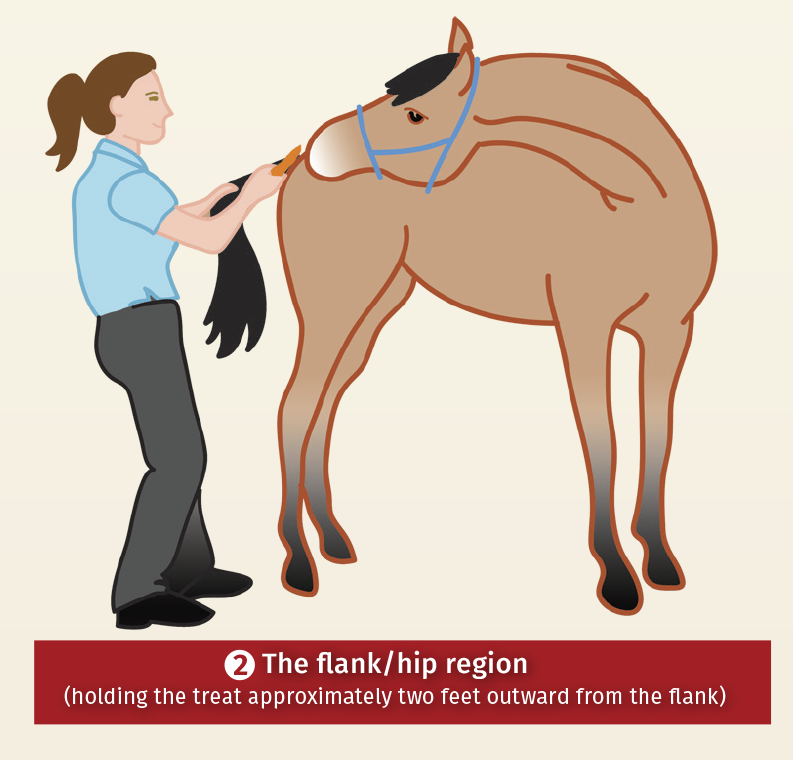
2) Now ask him to reach his head back further towards his flank. Aim to get him to reach as far as his stifle.
Repeat the two above stretches on the opposite side.
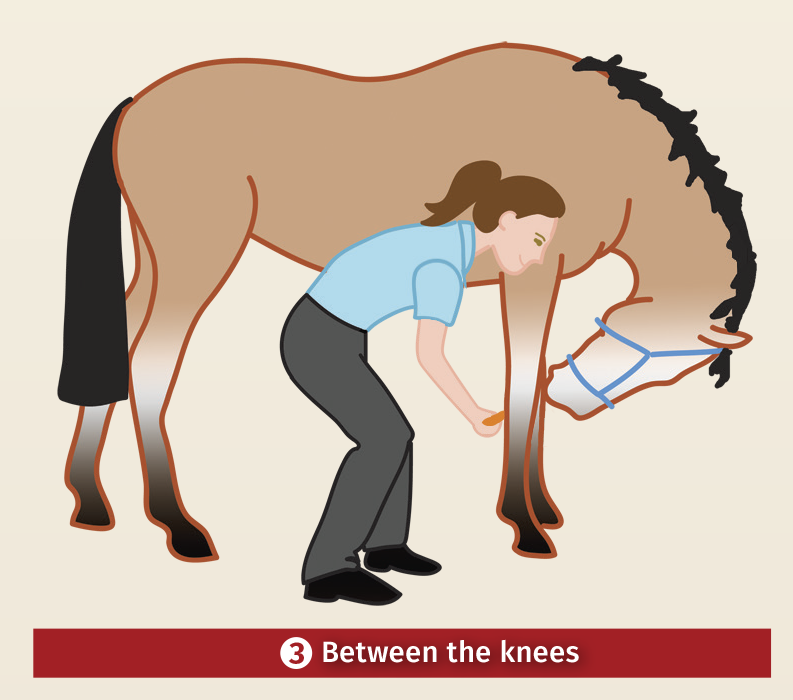
3) Then ask the horse to retrieve the treat from between his front legs, at knee height. You’ll want to hold the treat behind his front legs and ask him to reach his nose between his legs.
Choose from the routines suggested above, or combine them together to create a focused period of effectively changing or improving your horse’s body mechanics in the case of rehabs or horses needing re-schooling. Depending on the extent of your horse’s needs, this period should last seven days to six weeks, at which time you should note visible changes — muscle appears softer and not rigid, the horse travels with longer strides and carries himself with improved posture. At this time, you can begin schooling him in a regular riding routine while continuing your calisthenics on the side. His large gymnastic muscles will now have a new language that causes them to develop in different ways. They will be well synchronized with the underlying structures that support them.
Related: The Benefits of Cantering Your Horse
Photo: iStock/RomaOslo



